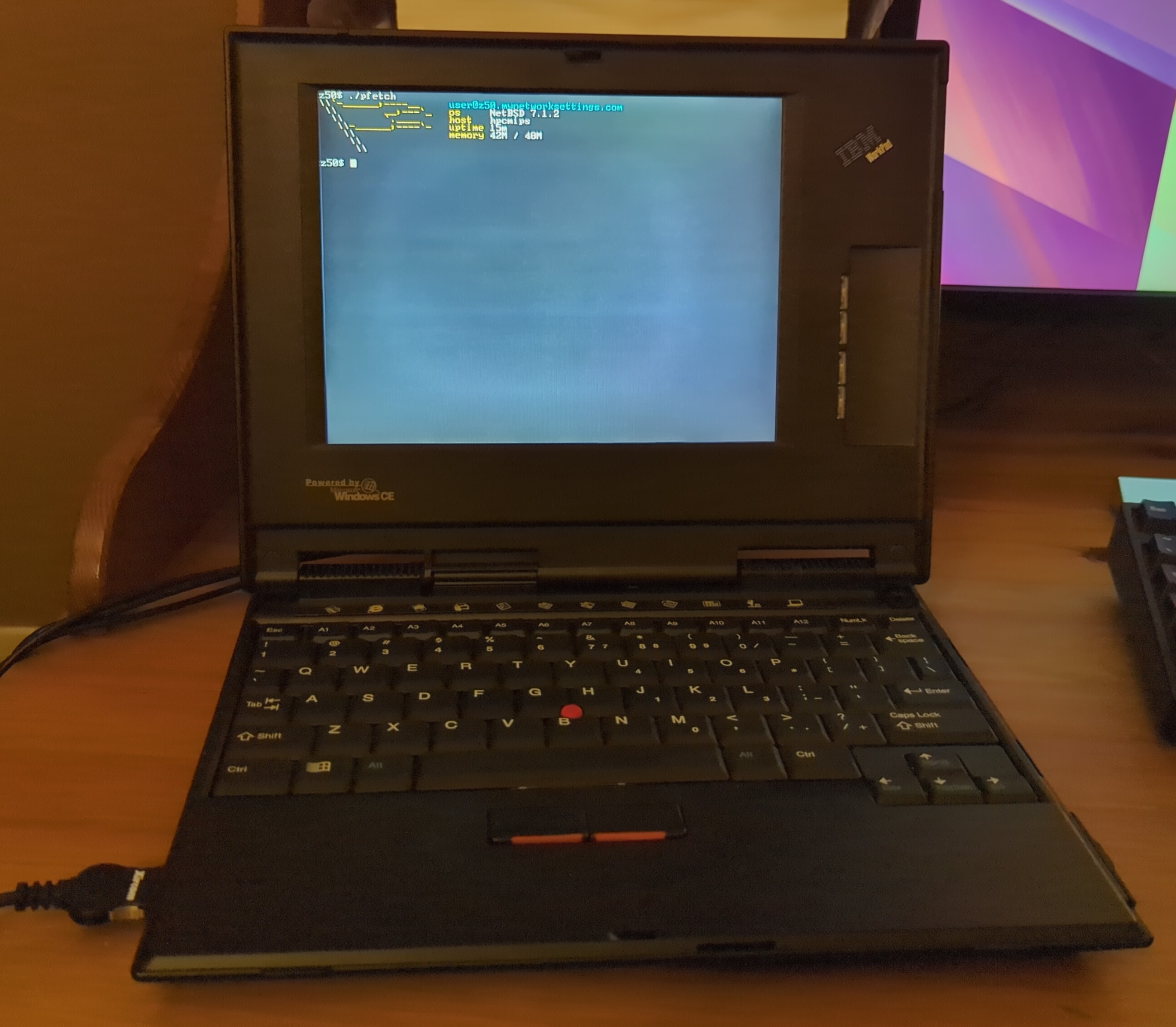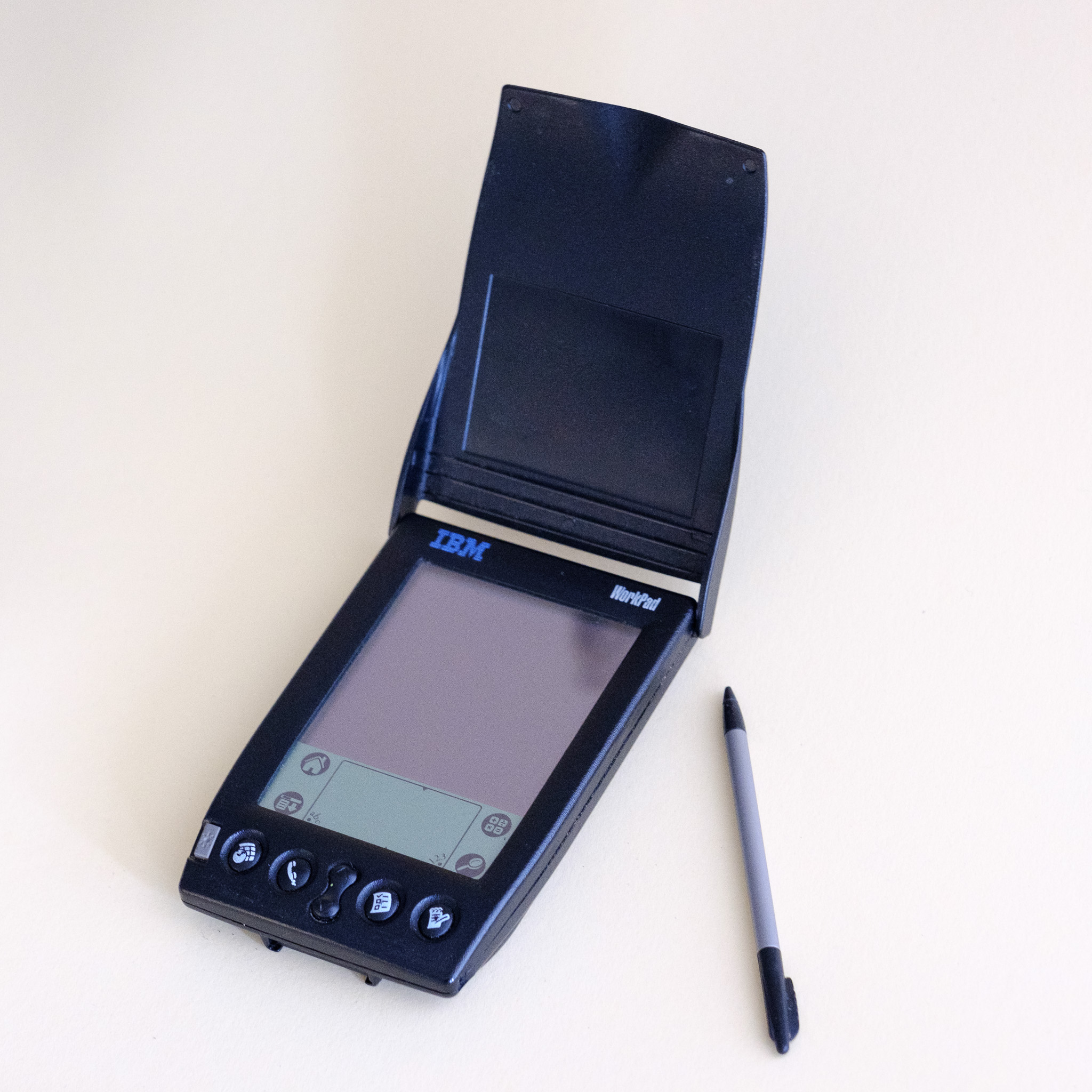|
IBM WorkPad Z50
The IBM WorkPad z50 is a handheld PC that was marketed by IBM as part of the IBM WorkPad series. It runs on Windows CE. Unlike the rest of the devices in the IBM WorkPad series it is a subnotebook and not a Personal digital assistant, PDA. History It was released in 1999 for a price of $999. Specifications z50 is a subnotebook, weighing 1206 g, with up-to 8 hours battery life from its Li-ion battery. It uses MIPS architecture processors, MIPS 4100 CPU (NEC VR4121) at 131 MHz, and features 16 MiB Random-access memory, RAM (expandable up to 48 MiB with the official expansion pack) and Read-only memory, ROM. It has a 640x480 display. Wired (magazine), WIRED noted that it bears similarity to the ThinkPad series. It has been delivered with Windows ce, Windows CE. NetBSD is also compatible with the z50. Reception PC Mag noted the great keyboard and large amount of RAM. References External links Review {{IBM personal computers Windows CE devices IBM laptops, W ... [...More Info...] [...Related Items...] OR: [Wikipedia] [Google] [Baidu] |
Handheld PC
A handheld personal computer (PC) is a miniature computer typically built around a clamshell form factor and is significantly smaller than any standard laptop computer, but based on the same principles. It is sometimes referred to as a ''palmtop computer'', not to be confused with Palmtop PC which was a name used mainly by Hewlett-Packard. Most handheld PCs use an operating system specifically designed for mobile use. Ultra-compact laptops capable of running common x86-compatible desktop operating systems are typically classified as subnotebooks. The first hand-held device compatible with desktop IBM personal computers of the time was the Atari Portfolio of 1989. Other early models were the Poqet PC of 1989 and the Hewlett Packard HP 95LX of 1991 which run the MS-DOS operating system. Other DOS-compatible hand-held computers also existed. After 2000 the handheld PC segment practically halted, replaced by other forms, although later communicators such as Nokia E90 can be c ... [...More Info...] [...Related Items...] OR: [Wikipedia] [Google] [Baidu] |
IBM WorkPad
IBM WorkPad was a line of portable devices, produced by Palm Inc. and branded by IBM. This line contained personal digital assistants (PDAs) and one subnotebook model (WorkPad Z50). Overview This line was released in 1997 and discontinued in 2002. After discontinuation of its self-branded line, IBM still offers the main Palm line on its site. This IBM-branded line of PDAs were rebranded PalmPilots, with only a few software improvements (easy sync for Lotus Notes, DB2 EveryPlace, and IBM Mobile Connect). Reception Early WorkPad PDAs were received positively, similar to parallel Palm models; but later this conservative business-oriented line lacked notability, and multimedia options of latest models were described as relatively poor. Models WorkPad Z50 - 1999, subnotebook/thin client, powered by Windows CE, equipped with an NEC MIPS processor and with an 8.2" screen. PDAs All WorkPad PDAs have a similar gray-scale screen (with better resolution and contrast for C series, ... [...More Info...] [...Related Items...] OR: [Wikipedia] [Google] [Baidu] |
Windows CE
Windows Embedded Compact, formerly Windows Embedded CE, Windows Powered and Windows CE, is an operating system subfamily developed by Microsoft as part of its Windows Embedded family of products. Unlike Windows Embedded Standard, which is based on Windows NT, Windows Embedded Compact uses a different hybrid kernel. Microsoft licenses it to original equipment manufacturers (OEMs), who can modify and create their own user interfaces and experiences, with Windows Embedded Compact providing the technical foundation to do so. The current version of Windows Embedded Compact supports x86 and ARM processors with board support package (BSP) directly. The MIPS and SHx architectures had support prior to version 7.0. 7.0 still works on MIPSII architecture. Originally, Windows CE was designed for minimalistic and small computers. However CE had its own kernel whereas those such as Windows XP Embedded are based on NT. Windows CE was a modular/componentized operating system that serv ... [...More Info...] [...Related Items...] OR: [Wikipedia] [Google] [Baidu] |
Subnotebook
Subnotebook, also called ultraportable, superportable, or mini notebook, was a marketing term for laptop computers that are smaller and lighter than a typical notebook-sized laptop. Types and sizes As typical laptop sizes have decreased over the course of the 2010s, and other distinguishing features have become mainstream, the distinction between regular-size and 'subnotebook' laptops has largely disappeared. To the extent that it still exists, 'subnotebook' could be defined as machines with screen smaller than 13" but with a permanently-attached keyboard intended for two-handed typing. Prior to this convergence, subnotebooks were also distinguished from netbooks and ultra-mobile PCs, based on both size and market position. Classic subnotebooks were smaller than full sized laptops but larger than handheld computers. They were distinguished by smaller screens and bodies and lighter weights relative to contemporaneous laptops. The savings in size and weight were often achieve ... [...More Info...] [...Related Items...] OR: [Wikipedia] [Google] [Baidu] |
Personal Digital Assistant
A personal digital assistant (PDA), also known as a handheld PC, is a variety mobile device which functions as a personal information manager. PDAs have been mostly displaced by the widespread adoption of highly capable smartphones, in particular those based on iOS and Android. A PDA has an electronic visual display. Most models also have audio capabilities, allowing usage as a portable media player, and also enabling many of them to be used as telephones. Nearly all modern PDAs can access the Internet, intranets or extranets via Wi-Fi or Wireless WANs, letting them include a web browser. Sometimes, instead of buttons, PDAs employ touchscreen technology. The first PDA, the Organiser, was released in 1984 by Psion, followed by Psion's Series 3, in 1991. The latter began to resemble the more familiar PDA style, including a full keyboard. The term ''PDA'' was first used on January 7, 1992 by Apple Inc. CEO John Sculley at the Consumer Electronics Show in Las Vega ... [...More Info...] [...Related Items...] OR: [Wikipedia] [Google] [Baidu] |
MIPS Architecture Processors
Since 1985, many processors implementing some version of the MIPS architecture have been designed and used widely. MIPS microprocessors The first MIPS microprocessor, the '' R2000'', was announced in 1985. It added multiple-cycle multiply and divide instructions in a somewhat independent on-chip unit. New instructions were added to retrieve the results from this unit back to the processor register file; these result-retrieving instructions were interlocked. The R2000 could be booted either ''big-endian'' or ''little-endian''. It had thirty-one 32-bit general purpose registers, but no status register (''condition code register'' (CCR), the designers considered it a potential bottleneck), a feature it shares with the AMD 29000, the DEC Alpha, and RISC-V. Unlike other registers, the program counter is not directly accessible. The R2000 also had support for up to four co-processors, one of which was built into the main ''central processing unit'' (CPU) and handled exceptions, ... [...More Info...] [...Related Items...] OR: [Wikipedia] [Google] [Baidu] |
Random-access Memory
Random-access memory (RAM; ) is a form of computer memory that can be read and changed in any order, typically used to store working data and machine code. A random-access memory device allows data items to be read or written in almost the same amount of time irrespective of the physical location of data inside the memory, in contrast with other direct-access data storage media (such as hard disks, CD-RWs, DVD-RWs and the older magnetic tapes and drum memory), where the time required to read and write data items varies significantly depending on their physical locations on the recording medium, due to mechanical limitations such as media rotation speeds and arm movement. RAM contains multiplexing and demultiplexing circuitry, to connect the data lines to the addressed storage for reading or writing the entry. Usually more than one bit of storage is accessed by the same address, and RAM devices often have multiple data lines and are said to be "8-bit" or "16-bit", etc ... [...More Info...] [...Related Items...] OR: [Wikipedia] [Google] [Baidu] |
Read-only Memory
Read-only memory (ROM) is a type of non-volatile memory used in computers and other electronic devices. Data stored in ROM cannot be electronically modified after the manufacture of the memory device. Read-only memory is useful for storing software that is rarely changed during the life of the system, also known as firmware. Software applications (like video games) for programmable devices can be distributed as plug-in cartridges containing ROM. Strictly speaking, ''read-only memory'' refers to memory that is hard-wired, such as diode matrix or a mask ROM integrated circuit (IC), which cannot be electronically changed after manufacture. Although discrete circuits can be altered in principle, through the addition of bodge wires and/or the removal or replacement of components, ICs cannot. Correction of errors, or updates to the software, require new devices to be manufactured and to replace the installed device. Floating-gate ROM semiconductor memory in the form of era ... [...More Info...] [...Related Items...] OR: [Wikipedia] [Google] [Baidu] |
Wired (magazine)
''Wired'' (stylized as ''WIRED'') is a monthly American magazine, published in print and online magazine, online editions, that focuses on how emerging technologies affect culture, the economy, and politics. Owned by Condé Nast, it is headquartered in San Francisco, California, and has been in publication since March/April 1993. Several spin-offs have been launched, including ''Wired UK'', ''Wired Italia'', ''Wired Japan'', and ''Wired Germany''. From its beginning, the strongest influence on the magazine's editorial outlook came from founding editor and publisher Louis Rossetto. With founding creative director John Plunkett, Rossetto in 1991 assembled a 12-page prototype, nearly all of whose ideas were realized in the magazine's first several issues. In its earliest colophon (publishing), colophons, ''Wired'' credited Canadian media theorist Marshall McLuhan as its "patron saint". ''Wired'' went on to chronicle the evolution of digital technology and its impact on society. ' ... [...More Info...] [...Related Items...] OR: [Wikipedia] [Google] [Baidu] |
ThinkPad
ThinkPad is a line of business-oriented laptop computers and tablets designed, developed and marketed by Lenovo, and formerly by IBM until 2005, when IBM's PC business was acquired by Lenovo. ThinkPads have a distinct black, boxy design language, inspired by a Japanese ''bento'' lunchbox, which originated in 1990 and is still used in some models. Most models also feature a red-colored trackpoint on the keyboard, which has become an iconic and distinctive design characteristic associated with the ThinkPad line. The ThinkPad line was first developed at the IBM Yamato Facility in Japan, and the first ThinkPads were released in October 1992. It has seen significant success in the business market. ThinkPad laptops have been used in outer space and for many years were the only laptops certified for use on the International Space Station. ThinkPads have also for several years been one of the preferred laptops used by the United Nations. History The ThinkPad was developed to ... [...More Info...] [...Related Items...] OR: [Wikipedia] [Google] [Baidu] |
Windows Ce
Windows Embedded Compact, formerly Windows Embedded CE, Windows Powered and Windows CE, is an operating system subfamily developed by Microsoft as part of its Windows Embedded family of products. Unlike Windows Embedded Standard, which is based on Windows NT, Windows Embedded Compact uses a different hybrid kernel. Microsoft licenses it to original equipment manufacturers (OEMs), who can modify and create their own user interfaces and experiences, with Windows Embedded Compact providing the technical foundation to do so. The current version of Windows Embedded Compact supports x86 and ARM processors with board support package (BSP) directly. The MIPS and SHx architectures had support prior to version 7.0. 7.0 still works on MIPSII architecture. Originally, Windows CE was designed for minimalistic and small computers. However CE had its own kernel whereas those such as Windows XP Embedded are based on NT. Windows CE was a modular/componentized operating system that serv ... [...More Info...] [...Related Items...] OR: [Wikipedia] [Google] [Baidu] |



_cmd.exe_Command_Prompt_800x574.png)
_-_Computer_History_Museum.jpg)


